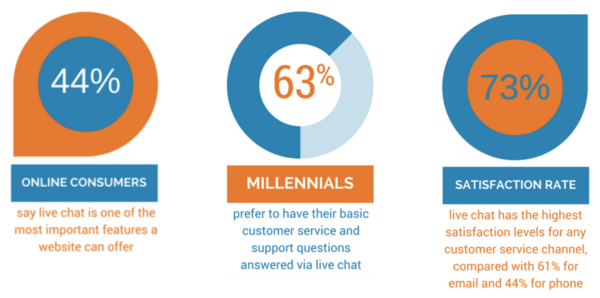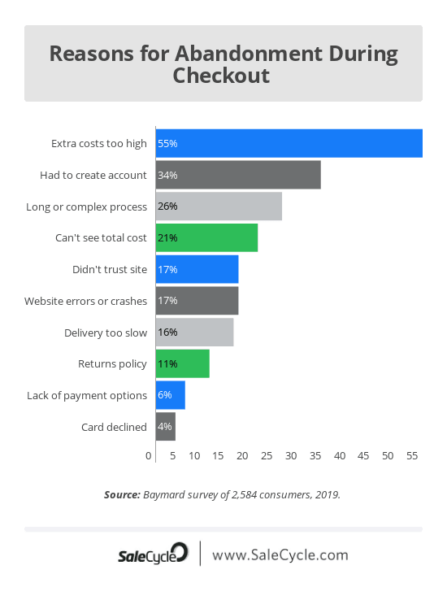Looking to up your game in the competitive SaaS market? Committing the same marketing faux pax as your competition won’t get you anywhere.
But mistakes are common in the world of marketing…
After all, none of us were born experts. But to stand out from the crowd, you have to make expert decisions and stand out from the crowd of SaaS companies using the same old strategies.
So in this article, I’ll show you my 6 best strategies to up your SaaS marketing game and take it to the next level.
Ready to dive in? Let’s go.
SaaS Sales Strategies to Crush Your Competition
Strategy # 1: Use Live Chat to Gain Customer Attention
Live chat is an awesome way to stand out from the boring, old SaaS websites out there. It’s essentially a service on your website that allows you to communicate 1-on-1 with your potential customers.
Live customer service has been around for a long while— it’s been around at least 50 years. But today it’s better than ever because you can even use robot AIs to start up your chats, and the technology is only improving.
And the best part is that it’s fast— most issues get solved in just 42 seconds.
Why is it so cherished among SaaS companies? Take a look at this graph which details some stats about live chat:
https://blog.snapengage.com/hipaa-compliant-live-chat-support-for-healthcare/
As you can see, live chat makes people happy. It’s the best way to connect with your visitors, and it separates you from the other companies by making your company more human-like.
And nobody wants to buy products from a robot (at least… not yet).
There are a few key benefits to using live customer support.
Boost customer leads by personalizing their experience
Most SaaS companies have software that’s packed-full of features and to the average consumer, it can be quite daunting and confusing. This is where you can step in and help.
Giving a personalized experience to your visitors helps take away that feeling of being overwhelmed— you can help them directly and highlight relevant features to each individual visitor.
Average SaaS websites rake in only 1-2% conversions— when companies introduced live chat, they were able to bring in over 27% of inbound leads. That’s a whole lot of more potential customers.
Increased revenue from more leads
Once you get those potential customers, you’re more likely to seal the deal— 38% of consumers are more likely to buy from a company if they offer live chat support.
And 79% of businesses who implemented live chat saw an increase in customer loyalty, sales, and revenue. And just like receiving a personal text or instant message, you’ll build that human connection with your customers.
You can use one live chat rep to talk to multiple visitors
One chat rep can answer 3-6 visitors at once. That means you’ll avoid the delays and frustration that come from phone and email communication.
Also, chat reps can be anywhere in the world— as long as they can type English, your live chat representatives don’t need an office.
Actionable Steps:
- Set up a live chat.
This one’s obvious, but where do you start? There’s a ton of live chat software out there— but a poorly designed, hard-to-use live chat is worse than no live chat at all.
Some good ones you can set up are Intercom, Drift, or Olark.
Need help in deciding the best software? Take a look at How to Choose the Best Live Chat Software.
- Monitor the effectiveness of your live chats
Great! You’ve set up a live chat. Now to see how that baby’s boosting your sales (or not).
Take a look at different metrics to measure effectiveness, such as first response time (the amount of time it takes for an agent to respond to a chat request) or first contact resolution (the % of issues resolved during the first chat).
Got your live chat up and ready? Good! Let’s move onto the next step.
Strategy # 2: Send Abandoned Cart Emails to Win Back Customers
Look, sales don’t just instantly happen, even if we want them to. They take time. A big misconception out there is that sales are like an impulse buy, like how kids buy Snickers bars while waiting in line at the grocery store.
But if you wait too long— especially after they’ve put your product in their cart and left your website— it might already be too late.
Enter: the abandoned cart email.
An abandoned cart email is pretty self-explanatory. It helps gain back customers after they’ve left, and you can even add in promotional offers or discounts to really reel them back in.
Why do customers abandon their carts, anyway? Take a look at this nifty infographic which details why:
They may be distracted, simply forgot, had website issues, don’t like the price or shipping costs, or are just simply browsing. Now onto the benefits!
Boost conversion rates by winning back customers
The most obvious benefit is you’ll increase that sweet, sweet conversion rate. A study by Barilliance found that conversion rates from cart abandonment emails are 18%, with some getting as high as 40%.
You can also gain a little extra by upselling customers— by offering combo deals in emails, you’ll further increase average order values. Sweet, right?
Boost your relationships with customers
Using cart abandonment emails to re-engage with customers allows you to personalize emails to them. If they entered their personal details before leaving your website, you’ll have access to a wealth of info!
Use that to your advantage. Address them by their name, injecting some of your company’s personality into the email to show them you care. You’ll likely stand out by being more memorable and unique from those other SaaS companies.
Now, let’s get down to the work.
Actionable steps:
- Set up your own abandoned cart email strategy.
Everybody’s email strategy is different, but you’ll want a few things to really stand out. Try including:
- A well-crafted subject line
- A call-to-action
- Eye-catching graphics
- A sense of urgency
For more detailed info, check out 5 Steps to Building a Cart Recovery Email Strategy That Will Increase Your Conversions.
- Find out exactly why your customers aren’t biting.
To reduce abandoned cart emails in the first place, try to get to the root cause of it. Using tools like Google Analytics and researching your audience and their expectations, as well as competitor’s products, can help you find the reasons why.
You can also send out surveys to your customers through email to find out and address their pain points about your SaaS product.
Got your abandoned email strategy? Let’s move onto #3.
Strategy # 3: Automate Your Marketing Using Marketing Tools
Marketing needs automation, too. And the sooner you get things automated, the sooner you’ll have more time you can spend for other (more important) things.
Marketing tools help reduce or eliminate those repetitive, tedious tasks. They include:
- Email campaign creation
- SMS messaging
- Website widget content
- Online ad placement
- Data management
Using automation makes these processes much more efficient, and gives you more of what money can’t buy: time.
You’ll be so fast and efficient, your competition won’t even be able to catch up with you.
https://giphy.com/gifs/Bu8ADbj7NuRry
Save time, get more money
Companies that use marketing automation are able to get more buyers with the time saved. Greater customer retention, loyalty, and web traffic will result in the free time you get when you can spend more time focusing on overall strategy and generating better leads.
91% of marketing automation users say that using marketing automation is “very important” to their overall online marketing efforts as well; and no doubt, saving time is in their top benefits.
Getting the right content to the right buyer… at the right time
Marketing automation tools can be used to target content at each stage of research, gathering relevant info such as what emails customers are opening, what posts are performing well on social media channels, and more.
Gathering this data, marketing automation systems will help generate more leads and lead to more revenue for your Saas business.
So how do you capitalize on these benefits?
Actionable Step:
- Create your automation strategy for your SaaS
Creating your automation strategy can be done in 4 steps:
- Determine the life cycle funnel of your product
- Determine the metrics for every stage of the funnel
- Create a map of the journey your customers will take
- Build your SaaS marketing automation workflow
Check out these steps in detail here.
After you’ve got rock-solid automation, let’s move onto the hottest thing on the block: social media.
Strategy #4: Connect with Users via Social Media
SaaS products aren’t exactly the hottest, easy-to-advertise products on the market. And displaying them in action and making them appealing is something that takes a lot more work than it may seem.
Need to stand out? Just throw on some chains, yo.
So to capitalize on making the best of SaaS products, you’ll have to turn to the most popular platform for digital advertising, social media.
Social media marketing comes in all forms, such as Facebook, Twitter, and Instagram to name a few.
So why do Social Media Marketing? If you’ve already got a solid SaaS product, you’ll reap some awesome benefits.
Increased recognition leads to more loyalty and credibility
The truth is about 93% of marketers said that social media marketing was important for their SaaS company. And that’s because social media can command a ton of people if done properly.
You’ll gain visibility in the social media sphere, which leads to customers recognizing your brand as a stand-out brand and expert in your field. People will trust your company more, gaining that amazing credibility as a result.
Your customers will communicate better
If you have a solid social media framework, you’ll be able to communicate directly on a platform where your customers feel comfortable. They’ll be able to post, comment, like or share your products to improve click rates and create more trust and credibility.
And the increased sales don’t hurt, either. So how do we do this?
Actionable steps:
- Create a social media strategy.
The first thing you’ll need is a solid strategy, which includes setting social marketing goals (such as generating leads/sales, growing your audience, etc.).
You’ll also need to analyze your competition to find out what they’re up to, as well as find out your most important metrics such as the number of clicks on your content or engagement rates.
- Get a social media audit
A social media audit is a form of evaluation of your performance in the area of social media. Getting an audit can help you recognize possible bottlenecks in your strategy. You’ll be able to know what strategies convert and deliver you the best results.
Otherwise, it’s nothing but guesswork.
Your Customer’s Success is Your Success
Remember, after implementing these strategies for your SaaS company, the most important thing to keep in mind is that customers come first.
It’s an old saying, but customers really are the backbone of any successful SaaS company. “Smart companies have realized that customer loyalty is the most powerful sales and marketing tool that they have,” says Bill Price.
And when you are able to use these strategies to build up customers who love what you’re selling, you’ll not only have the money but make countless people happy, too.
And that’s the best thing money can’t buy.
Read more:





